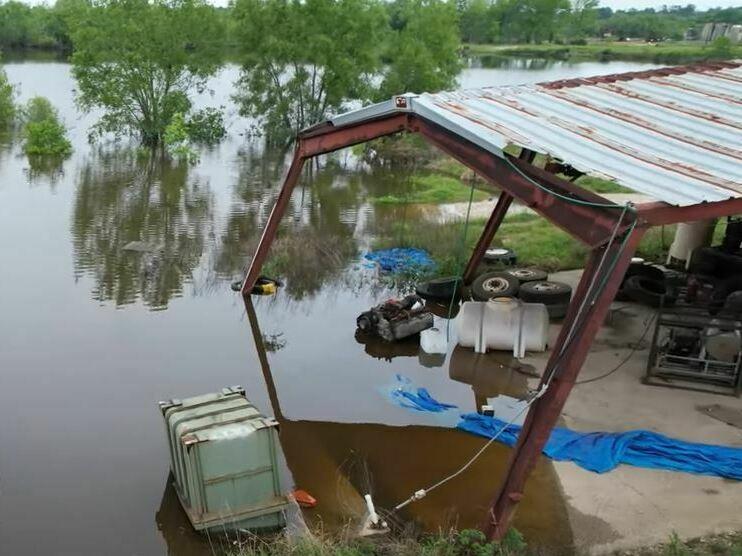Section Branding
Header Content
Texas residents wait and watch as a sinkhole in their town grows
Primary Content
Getting swallowed up by the gaping maw of the ground beneath one's feet is the stuff of nightmares. And it is what's happening — again — in the small Texas town of Daisetta.
A huge sinkhole that had appeared to be stable for more than 15 years suddenly began expanding about a week ago, growing by several acres and leaving nearby residents terrified that it will take them and their homes.
Video footage taken by Bluebonnet News on Sunday shows buildings, tank containers and other structures partially submerged in water. Deep cracks in the earth emanate from the dark pool like veins, running beneath empty warehouses and heavy equipment.
Years ago, the original crater made national news after suddenly collapsing on May 8, 2008. Over two days, it grew from a 20-foot hole to a cavity measuring about 900 feet across and 260 feet deep.
Eventually, the community learned to live with the giant hole in the ground, treating it as something of a recreational area. As USA Today reported, "alligators have inhabited the waters and some Daisetta residents fish in the sinkhole's pond-like surface."
It remained visibly unchanged until April 2, when residents reported that it had taken out several more acres, according to The Vindicator.
"My neighbor came over and said he kept hearing popping sounds like a gunshot. We went to the backyard, and there were buildings falling in. It was like a movie. You can see cracks forming in the ground," resident Tim Priessler told ABC 13 on April 3.
His wife, Jordana Priessler, added: "I was having a lot of trouble going to sleep last night because I didn't know if we were going to get swallowed up. My family told me it happened kind of fast before."
Since then, a vacant building and several storage tanks have been consumed by the hole.
Experts are surveying the site
News outlets report that the site is being investigated by multiple agencies, working to figure out what triggered the latest collapses. Meanwhile, the Environmental Protection Agency is analyzing the contents of nearby tanks — currently sitting along the new edges — to determine if they contain hazardous material that could pose other risks.
City officials said last week that they would be working with local and state agencies, including the Liberty County Judge, the Liberty County Fire Marshall, and the Texas Division of Emergency Management to keep residents notified of relevant changes.
The sinkhole sits on what was once the DeLoach Oil and Gas Waste Well. The Vindicator reports that the company is no longer in operation, "but storage of certain products remains on the property, which has seen a warehouse and several tanks give way to the path of the sinkhole."
As of Monday, town officials had not issued evacuation orders for residents.
How did this happen and what causes sinkholes?
Randall Orndorff, a research geologist with the U.S. Geological Survey, told NPR that the department ultimately concluded 15 years ago the culprits could be a combination of man and nature.
Orndorff was part of the team that was sent to study the sinkhole when it first collapsed in 2008.
He explained that the entire town of Daisetta, which is a little over an hour northeast of Houston, is built on a salt dome. It is one of a few dozen in the Gulf Coast region, according to the Center for Land Use Interpretation.
Oil and gas companies looking to dispose of the waste that's created by drilling use the salt domes as underground storage facilities.
"They drill these vertical holes and pump the waste down there and usually, everything is fine," Orndorff said. "But the problem is salt is dissolvable."
He noted that the region has been struck by powerful hurricanes over the years, including Hurricane Ike, which struck Daisetta just four months after the first sinkhole appeared.
"When you get a lot of precipitation, everything's dissolving in the bedrock," creating new caves, he said.
Meanwhile, the soil on the surface begins to shift and move down into the gaps.
"That means that you could have this void underneath your feet and never know it. As time goes by that void is getting closer and closer to the surface and then you add all of the weight of water from a heavy rain or a storm and it just can't hold up," Orndorff explained.
"Boom! It just collapses."
Orndorff has not visited the site for more than a decade, but in recent days, he has reviewed a number of drone videos showing the growing sinkhole from above. He told NPR that based on what he has seen, "the current growth is occurring in one spot and not the entire sinkhole."
Copyright 2023 NPR. To see more, visit https://www.npr.org.

